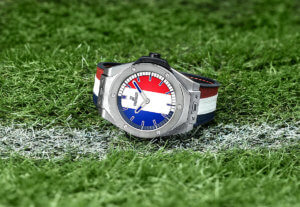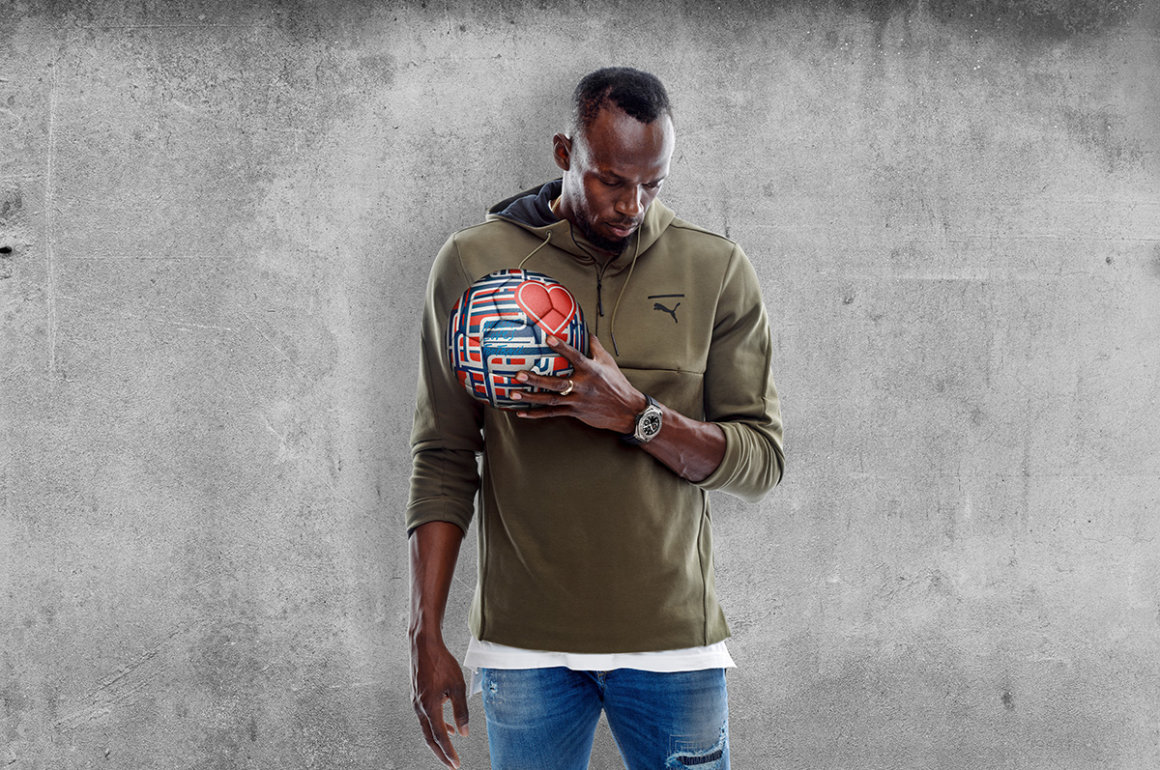
The Big Bang Unico Teak Italia Independent, only 100 of which were made
Hublot is fusing smart technology with sleek design to enthral a new generation of customers. Jason Barlow reports
Hublot is enjoying a renaissance. A renaissance that began with four weeks in the global spotlight this June, its prominence during the most compelling football World Cup in a generation exposing this most quixotic of watch brands to a huge new audience.
Inspiring an allegiance between a brand and a client is way more complicated than simply (expensively) forging a partnership with the world’s biggest football tournament, Formula One, or any number of individual ambassadors. Clearly, it helps. But it also helps when the brand in question has something genuinely interesting to say. There are lodestar names in the world of haute horology – Rolex, Patek Philippe, Audemars Piguet – and there are arrivistes, upstarts. Too many to name, in fact, and each freighted with a different set of promises. But certain attributes rise above the rest. Innovation. An engineered aestheticism. Authenticity. This last one is a cornerstone of the entire luxury edifice, and takes time to establish.
Follow LUX on Instagram: the.official.lux.magazine
Some get there with incredible rapidity: to take an example from a parallel world, Bugatti began making cars in 1909, artisanal Italian supercar maker Pagani only in 1992. The latter’s cars are the Fabergé eggs of the automotive sphere, precious beyond belief, Pagani’s connection with its clients the ne plus ultra of the car world. Or think of the Marchesi Antinori winery, whose classic Chianti production spans an incredible 26 generations, all the way back to 1385. An astonishing HQ in Bargino, Tuscany, acts as a temple to Antinori’s status and relentless ambition.

Hublot CEO Ricardo Guadalupe and Jean- Claude Biver, head of watchmaking at LVMH
Hublot made its debut in 1980, but has navigated its way to a position of formidable brand power. In 2017, it enjoyed a record year, with a growth in sales of 12 percent, against an industry-wide backdrop of reduced revenues. How has it achieved this? CEO Ricardo Guadalupe’s approach is a fascinating one to dissect. “At Hublot, we strive to have technology at the service of the aesthetics,” he explains. “For us, it is not a battle but a right mix to find.”
I ask Guadalupe to delineate the brand’s ambassador strategy.
“Firstly, we go where our clients are! We continuously focus on our customers, we elaborate our partnerships in accordance with the interests of our clients, to better suit their needs and their expectations. Football, cars, art and music are such areas where our customers are.
Read more: Moynat unveils new collection of bags in London
“We are partnered with FIFA and UEFA, which are the two most important organisations in the football universe. And with Ferrari, which is certainly the most famous car brand in the world. We do things
according to our motto: ‘First, unique, different.’ When entering a new partnership, we always research to fuse our world with that of the ambassadors. What is important is that the potential ambassador is already a Hublot client and that he/she loves the brand. This really matters for us.”

Brand ambassador Usain Bolt
It’s sometimes tempting to think that many high-end brands are 70 percent marketing confections, 30 percent watch. Tuning this approach with the right sensitivity and science is something Guadalupe and his team are acutely aware of.
“We try to have the same strategy for all the countries in order to allow everybody to be part of the Hublot world,” he says. “But of course, we have some differences and some specificities for some markets. In China, we do not do print advertising, only digital. We also stage events around our boutiques or around the department stores where we are present. We have some ambassadors linked to their country: [pianist] Lang Lang is known all around the world but in China he is even more than a superstar.
“Our prices start from about £3,000 and we have a large selection at different prices. It means every person with a budget for a luxury watch can find his or her Hublot timepiece. Besides, we indeed think that we sell a dream, but it is not necessarily the most expensive watch. It is just about the emotion the client shares with their watch.”

The Big Bang Referee watch, to coincide with the 2018 World Cup
Entry points are moot. When former CEO of Hublot Jean-Claude Biver (now head of watchmaking at LVMH, to whom he sold the brand in 2008) decided to lower the barriers to TAG Heuer ownership to bring in the next generation of customers, it risked diluting its appeal to older, wealthier, arguably more discerning clients. Here, too, is another link with luxury brands beyond the watch world, and it had to be done. Ask any CEO in the automotive sector to outline the challenges they face, and high on the list will be reaching millennials. They simply don’t have the same relationship with cars that their parents did, partly because connectivity means something very different in 2018 than it did in 1988. The smartphone is the device that conquered the world, not always beneficently. So, how does Hublot tackle this challenge?
“As in the car, your first watch cannot be a Hublot,” Biver says in his typically forthright way. “You need some culture and knowledge, and most importantly you probably need to buy first one or two ‘classic’ or ‘traditional’ watches, before being ready for a disruptif and fusion watch.”
And what of the threat posed by so-called smart watches? Here, surely, is the item craved by millennials, at the expense of traditional watch-making.
“I am fully aligned with Mr Biver’s view,” says Guadalupe. “Smart watches should be considered as an advantage for the Swiss watchmaking industry because they conquer the wrist of people who weren’t wearing any watch. Moreover, one day, those young clients will also be interested in owning a piece of art on their wrist – and this is what we do.”

Hublot watches are still made in Switzerland

The brand collaborated with tattoo artist Maxime Büchi
Guadalupe also believes that Hublot’s very youth permits the disruption desiderated by so many brands, including some heritage names. It also liberates Hublot from the urge to simply reboot past successes. Instead of yet another tribute to something, he’s more interested in using new material, such as ceramic or sapphire. The partnership with Ferrari is emblematic of this approach: Hublot’s Techframe imports Ferrari’s expertise in advanced materials, to thrilling effect – how does titanium, King Gold or PEEK (polyether ether ketone) sound? Working with Italia Independent’s Lapo Elkann also maximises
the opportunity for what the fabulously flamboyant scion of the Agnelli family calls ‘contamination’. Tattoo artist Maxime Büchi has worked wonders there.
Read more: Château Mouton Rothschild supports restoration of Versailles
But back to connectivity, and Hublot’s unique manifestation of the concept.
“We created our first connected watch, the Big Bang Referee 2018 FIFA World Cup, as it was a specific need expressed by FIFA,” says Guadalupe. “Wanting a customised watch for the referees, FIFA asked Hublot to conceive the perfect watch to accompany them on the pitch during matches.
“Moreover, it was not possible to have all the necessary information on a mechanical watch, that is why we did a connected one. Nevertheless, it has all the attributes of the iconic Big Bang. Its emblematic architecture cut out of the lightness of titanium, its bezel decorated with six H-shaped screws, its Kevlar insert. Even the display on its analogue mode dial could pass for the same aesthetic as that of the automatic models. It is certainly a connected watch, but it is first and foremost a Hublot watch.”

Hublot’s ‘digital boutique’ launch in New York
Two other over-arching trends can’t be ignored. Firstly, does the resurgence of interest in ‘analogue’ – more vinyl records were sold in 2017 than any year since 1988 – favour Hublot?
“I think we must combine the two together,” says Guadalupe. “Digital is important and we must be into it if we want to keep in the era of time, but at Hublot, we keep thinking that it is important to merge tradition and innovation. It is not because we created a connected watch that we are forgetting the past. A key of our success is we are able to find the good balance between those elements.”
The other is the rise of ‘experiential luxury’, the realm that exists beyond the mere act of acquisition. This is a major preoccupation in the luxury world.
“Hublot is aware that the key asset of an excellent customer relationship is based on trust, availability and flexibility,” says Guadalupe. “We have innovatively imagined a ‘virtual’ digital boutique that perfectly complements the role and presence of its physical boutiques around the world. By remotely offering its customers 3D-facilitated access to its products, knowledge and knowhow, Hublot is successfully creating a new bespoke customer service, and preserving the essential denominator of any relationship – that is to say the human connection. It is a new customer experience that is beginning in the United States before being rolled out across the entire world.”
Hublot’s moment looks set to continue.
Discover Hublot’s collections: hublot.com
This article originally appeared in the LUX Beauty Issue. Click here to view more content from the issue.







Recent Comments